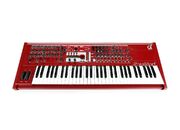
Waldorf Q keyboard, courtesy of synth4ever.com
A knob-festooned virtual analog synth introduced by Waldorf in 1999. Visually, besides the many knobs (mostly rotary encoders), the most striking feature of the Q was the bright yellow color of the original model. The Q was designed by Axel Hartmann.

Waldorf Q tabletop / rackmount, courtesy of synth4ever.com
The Q provided three oscillators, two of which were wavetable oscillators. 256 waveforms were available, and more could be loaded via a memory card. The filter section provided a number of response types including low pass, bandpass, high pass, and comb; a 256-band vocoder was also available. A number of effects were built in, and a multitimbral mode (with two additional sets of outputs for routing different patches) was available. Patch memory contained 300 patches. The keyboard version had a 61-key span and included pitch and mod wheels. A sequencer was included. A rack mount version was introduced at the same time; it contained fewer controls but was functionally identical. It was packaged so that it could either be mounted in a rack or used as a tabletop unit. Both versions were polyphonic with 16 voices, expandable to 32 by installing an expansion board.
In addition to the original yellow, models were also made with blue and dark grey paint schemes. Functionally, there was no differences between them, but there were internal changes during the production run. Some users swear that the original yellow ones sound better than the others. One year after the original keyboard and rack mounts were introduced, Waldorf followed these up with the Micro-Q. This was a smaller rack mount unit with only a few controls. Unlike the keyboard and older rack version, this version used DSP flex to provide up to 25 voices, depending on the complexity of the patch chosen. A limited edition of this was painted green and marketed as the "Mean Green Machine". It replaced the standard control labeling with comical notations, such as "Life" for the power button.

Waldorf Q+, courtesy of Matrixsynth
2002 saw the introduction of the Q+. The most significant changes from the standard Q were increasing the voice count to 100, providing up to five oscillators per voice, and the inclusion of 16 four-pole analog low pass filter circuits, based on the design of an old PPG filter. 16 of the voices could be routed through the analog filter, one per voice, or the filters could be configured in pairs, effectively providing eight-pole (48 dB/octave) response for eight voices. All original Q+ models were painted red.
Production of all of these models, as well as all other Waldorf products, ceased when Waldorf declared bankruptcy in 2004. In 2007, the re-formed Waldorf re-introduced the Q and Q+ keyboard models, and the Micro Q, as the Phoenix Editions. These had a black paint scheme but were otherwise very similar to the pre-bankruptcy models. All models were discontinued in 2011 due to parts obsolescence issues.